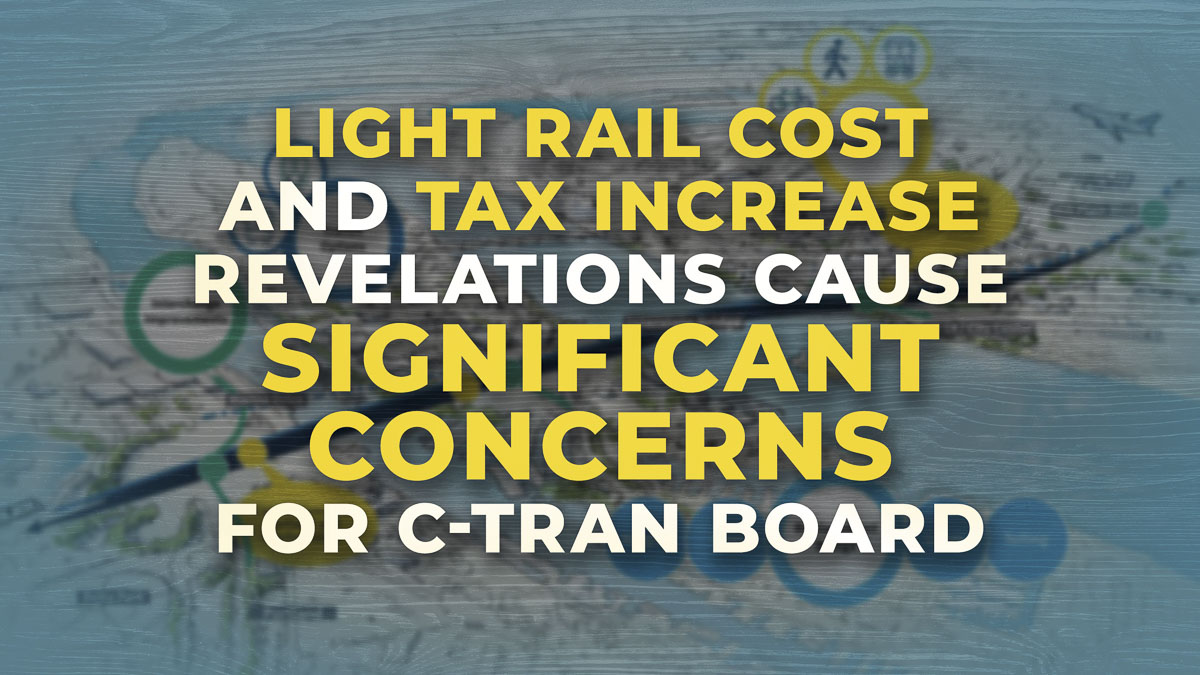
TriMet officials ask Washington to cover $7 million of IBR transit annual operating costs
John Ley
For Clark County Today
It was a long night full of uncomfortable discussions and revelations for the C-TRAN Board of Directors last week. Vancouver Mayor Anne McEnerny Ogle, chairman of the board, was agitated that funding for the MAX light rail extension into Vancouver was running into a roadblock. Cross-river transit ridership continues to be flat, reducing any real need for “high capacity” mass transit service.
The mayor was also worried about the change in control of both the White House and Congress. “The impact of the new administration is potentially significant,” the board was told. McEnerny-Ogle pushed hard for the state legislature to fund Clark County’s $7.2-million portion of a TriMet demand for new taxes to cover light rail Operating and Maintenance (O&M) costs.
Voters must approve a new sales tax to pay for the O&M of both light rail and bus service associated with the Interstate Bridge Replacement Program (IBR). The board was given two possible options to raise the money with a 0.1 or a 0.2 percent sales tax increase. The federal government “wants to make sure you’re not going to scavenge funds from other service you provide in order to pay for the high capacity transit,” said staff member Steve Witter.
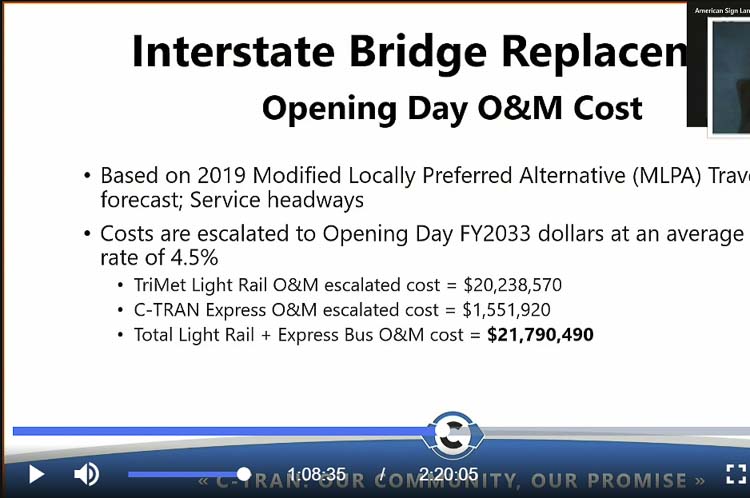
The proposal before the board indicated a 55 percent cost split to Oregon and 45 percent to Washington for the light rail component. It also allocated 62 percent of Express Bus service (C-TRAN routes #101 & #105) to Oregon and 38 percent to Washington. This was done by the distance/mileage of each service.
The light rail O&M costs are projected to be $20.2 million in 2033, and Express Bus costs of $1.55 million. TriMet used an average 4.5 percent assumed inflation rate in the calculations.
Farebox recovery was estimated to cover $5.45 million of the $21.7 million annual costs. That left Oregon paying $9.07 million and Washington paying $6.8 million towards light rail, plus C-TRAN would cover an additional $442,297 for Express Bus service. This makes the Washington share $7.27 million each year.
“I’m having sticker shock here,” said Vancouver City Council Member Bart Hansen. Counselors Michelle Belkot (Clark County) and Tim Hein (Camas) pushed back against the TriMet demand after details of the $21 million in projected costs were revealed.
The light rail transit cost is 384 times the cost of bus service, on a per mile basis. The 1.83-mile light rail extension and a 54.1-mile express bus route mileage.
Two and a half years ago, the TriMet Board of Directors demanded “new revenues” from both Washington and Oregon to pay for the O&M costs of the MAX light rail extension. Over a year ago, it was revealed they sought $21.6 million, to which the C-TRAN board said they would not be responsible for TriMet O&M costs.
That position changed at the November C-TRAN board meeting, where meeting minutes show Hein asked “why is the requested change proposed? What is wrong with the current language since it is not supportive of C-TRAN’s interest?”
Deputy CEO Scott Patterson said that the language in the resolution was not drafted or written by the C-TRAN team. It appears TriMet put the entire proposal together.
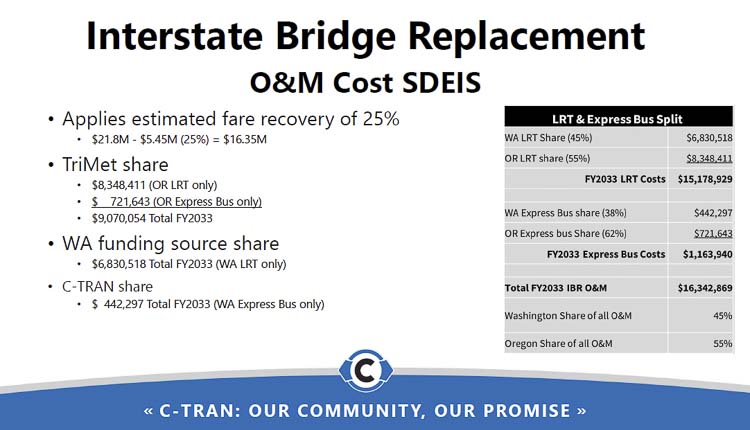
Former C-TRAN Board member Philip Johnson wrote the following in a letter. “I don’t know who in the organization wants to change this agreement, but any change at this point in my opinion will only allow the anti-public transportation/anti-bridge people to declare that once again C-Tran is selling out their Washington tax paying public and kowtowing to Trimet and Oregon. At that point, I may have to agree with them.”
Last week the board faced the reality of the November decision. “This looks to me to be C-TRAN subsidizing TriMet,” Belkot said.
“It seems to be in complete conflict with what I’ve known in the past,” said Hansen.
The $7.5 billion IBR has chosen a 1.83-mile extension (9,690 feet) of TriMet’s Yellow Line light rail for transit service on the proposed bridge. The current cost estimate ranges between $1.3 billion and $2 billion, making this potentially the most expensive rail project in the world, at $1 billion per mile. They are also demanding 19 new light rail cars at $190 million to $290 million, triple the cost they paid for four new cars on their 10 mile “Better Red” extension earlier this year.
TriMet and the IBR are supposedly promising light rail departures every 6 to 7 minutes. This contradicts all current data on transit ridership. C-TRAN staff briefed earlier in the meeting that cross river express bus ridership was essentially flat this year. Earlier this year, the Regional Transportation Council (RTC) reported a “new normal” that included more people working from home and significantly reduced transit ridership.
“At no point since the Yellow Line opened has ridership met projected levels,” the Cascade Policy Institute reports. “By 2020 the line’s ridership was expected to have 18,100 average weekday riders. In April 2019, ridership only reached 13,270. In August, 2024, Yellow Line ridership was 10,530, 42 percent below promised 2020 levels.“
Staff reported 2019 ridership was used for transit ridership projections. There will be an updated ridership model completed before a final request for federal funding is submitted to the Federal Transit Administration in 2026.
In FY 2022, TriMet spent $128.1 million on operations for its entire 60-mile MAX light rail system. That equals about $2.1 million per mile. Yet they are demanding over $10 million per mile for IBR O&M costs.”It’s $6.8 million to run light rail transit today and $442,000 to run the bus,” the staff told the board.
The cost numbers were provided by TriMet and escalated to 2033, when the new bridge would open and light rail service would begin. The Cascade Policy Institute has previously reported TriMet’s failure and inability to deliver anything more than 15-minute headways, or four departures an hour.
C-TRAN will be providing Bus on Shoulder (BOS) as part of the Modified Locally Preferred Alternative (MLPA) for 54.1 miles into downtown Portland.
Another complication was the total projected costs were allegedly offset by passenger fares. TriMet is predicting a 25 percent farebox recovery of operating costs. Yet when asked, the C-TRAN’s Scott Patterson said “the estimated farebox recovery of 25 percent is overly optimistic.”
The TriMet FY2024 Annual Report indicates passenger fares have dropped from $123 million in FY2015 to $59 million. Passenger fares cover 7.9 percent of the $931 million annual operating costs. Last year, TriMet lost $850 million, up nearly 30 percent from 2021’s loss of $656 million.
In Clark County, C-TRAN’s farebox recovery has dropped to under 5 percent. In the unlikely event farebox recovery doesn’t increase to 25 percent, taxpayers on both sides of the river will have to pay even more dollars to subsidize TriMet and the proposed light rail service.
Patterson told the board “the operating cost per hour (for MAX light rail) is significantly more than the operating cost for a bus.” Upon further questioning, it was revealed that the operating cost per hour is around 5 times as much as it is for a bus.
Hansen summed up the discussion. “We’re worried about where we’re going to come up with the revenue, when we should be worried about the costs,” he said. “There’s no way I could sell this with a straight face,” he concluded.
The mayor told the board and staff it takes two years for the Washington legislature to make changes for possibly funding the Washington portion of the IBR’s alleged O&M costs. She said this was a “unique opportunity” and wants staff to start the discussion immediately.
One might wonder why the board didn’t simply reverse their November decision. Prior to that their position was “C-TRAN will not participate in LRT O&M funding.” It was suggested the board have a day-long special meeting in February to do a “deep dive” into the details.
The legislature is facing a significant reduction in planned revenues. Asking them to pay for a financial obligation that belongs to an Oregon transit system is likely a huge stretch. Especially given the reality that Vancouver was allocated $1 billion of the $17 billion Move Ahead Washington 2022 transportation package for the IBR.
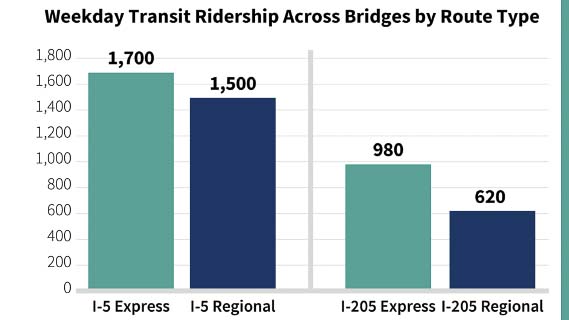
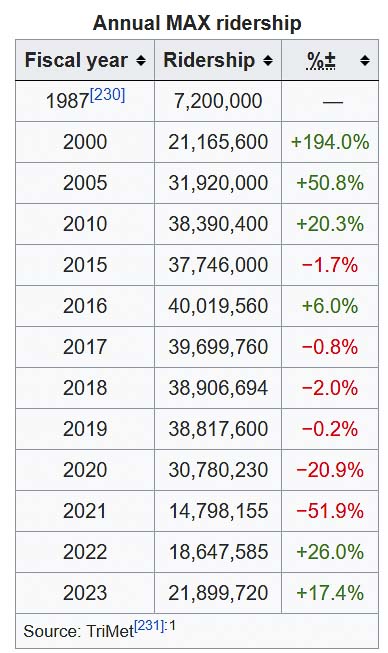
Also read:
- IBR only has single firm interested in managing the project to replace I-5 BridgeRep. John Ley reports on serious concerns with the I-5 Bridge replacement project, including limited contractor interest, rising tolls, and a 15-year timeline.
- Busy pavement season ahead on Vancouver streetsThe city of Vancouver is set to repave and preserve 76 lane miles across 20 neighborhoods in summer 2025, with ADA upgrades and community notices throughout.
- State representative: Expect sticker shock when Interstate Bridge project officials reveal price, tolling plansAt a town hall in Battle Ground, Rep. John Ley warned of major cost increases and tolling burdens tied to the Interstate Bridge replacement project.
- Opinion: Washington state lawmakers increase the cost of driving – againBob Pishue of Mountain States Policy Center argues that new vehicle and fuel taxes in Washington will raise driving costs while diverting funds away from roads.
- Overnight full closure of I-5 near Woodland for bridge inspection, May 6WSDOT will fully close southbound I-5 near Woodland overnight on Tuesday, May 6 for a bridge inspection using a chain drag test.










Question….Exactly where does Madam Mayor think the State of Washington gets its money??
Asking for a friend….
CTRAN meeting Dec. 10, still waiting for the slides from the meeting. Thank you for this detailed report.Ridership- Staff reported that the I-5 Express bus service, Routes 105 and 105X, ridership across the Columbia River is below 2019 levels. This alarmed Vancouver Mayor Anne Ogle who noted it would be a challenge to get funding with declining ridership on the I-5 route that supposedly “needs” high capacity transit, such as light rail.
Camas Councilor Tim Hein questioned the much higher costs to build and operate light rail, 5X the operating bus service that CTRAN offers now. Since there was no detail provided, it’s uncertain if the operations costs will be even higher than 5 X. For that matter, IBR has already stated that the current $7.5 Billion I-5 Bridge project costs will be higher, to be revealed in 2025.
CTRAN board members used to be faithful to November 2012 votes of every city in Clark County against extending TriMet MAX light across a proposed I-5 bridge, and raising the sales tax even higher to pay for it. Now CTRAN board members like Molly Coston from Washougal, Ron Onslow from Ridgefield, and former Battleground CTRAN representative Philip Johnson have voted FOR outrageously expensive Light Rail instead of affordable bus service, dishonoring the public votes of their respective cities. Adrian Cortes from Battleground likewise voted for LightRail as a member of the RTC board.
https://worksourceswwa.com/wp-content/uploads/ibr-job-opportunties-1.pdf?utm_medium=email&utm_source=govdelivery
Why has this link suddenly appeared through work source in Clark County? And, why have thousands of emails been sent with this info to those looking for work?
Good work John Ley. Thanks for the report.
https://worksourceswwa.com/wp-content/uploads/ibr-job-opportunties-1.pdf?utm_medium=email&utm_source=govdelivery
The state is already preparing to hire for this project
See people.. your voice in squelching this not loud enough! Get on the phone, get to your representative’s office. Someone please ask Marie what the heck is being forced down our throats!
Light rail seems like a great idea, but appears to be absolutely 100% unaffordable at the present time. If there was a way to get busses back and forth between Vancouver and Portland faster (bus only lanes, etc.), that would be the way to go. I think that is what they should be working on.
Beth —
They can, if they want to, “go faster”. C-Tran is in the early stages of running their “Bus on Shoulder” service, using the I-205 bridge. Once that “test” is done, there are plans to offer the same service on I-5.
That being said, CURRENT bus service is FASTER than the Yellow Line MAX light rail service, which travels an average of just 14 mph.
Another bit of reality is there is so little demand for transit service over the Columbia River, that TriMet does NOT offer it. They leave the entire market to C-Tran.
C-Tran used to offer SEVEN separate express bus lines over the Columbia River, using both I-5 and I-205. Once the pandemic lockdowns hit, they cut their service back to just 3 Express Bus lines. Two using I-5 and a single bus line using I-205. FYI.
John Ley, I agree with what you’ve said. And I’m familiar with the prior CTran levels of express bus service to and from Portland. I’m a retired CTran driver. I have driven the 105, 164, 199, 190 and 137. Those routes used to be sooo busy and sooo well used. It’s just not the same these days.
Listening to Mayor Ogle of Vancouver and one of the C-Tran Board members about ridership being flat, the IBR with lite rail, my blood boils. The Democrats may be a super majority in our legislature but they should NOT rule the roost on trans issues that are local. We the people in Clark County must have a say on the transportation issues between Portland and Vancouver. I know that state and federal funding is needed. BUT We have voted DOWN three times lite rail. We favor bus for mass transit. Even this is questionable as the ridership does NOT justify the expense of a bus lane, other than normal traffic travel.
When did C-Tran vote itself in favor of this lite rail that we voted in the country against it? Who justifies cost of C-Tran when the ridership does NOT. You see the buses almost daily if you are on the road. We have lived in this county since 1971. I do NOT remember ever seeing a bus with more than a dozen riders and usually five or less in those big buses. Mayor Olgo should be concerned about the Trump administration. We are in his “cheering section” to cut government spending, waste and fraud. With the concerns that I listened to on the video, the IBR with lite rail MUST be scrapped. C-Tran’s bus size should be reduced to meet actual ridership stats. There are smaller buses. The only C-Tran buses that I see that really fill a need are the very small ones that pick up handicapped, seniors and people without transportation. Every Sunday I see this C-Tran service bus come to our church and drop four handicapped people off and come back to pick them up. That is a real public service. This monster called IBR with lite rail needs to be revamped and put back to a public vote – remember “we the people”.
Of course, there are the buses that pick up and drop off the invisible people. I don’t see them all the time…
January 20th can’t get here soon enough…Hopefully DOGE can put an end to our misery…
I agree completely. We have seen ONCE five people riding the mill Plain Vine busses. Usually one or two riders for the extended bus.
I am not in favor of supporting a bridge with light rail at the proposed cost outlined to come from WA State taxpayers. I am retired and on a fixed income. Our taxes are high enough. I also support John Ley’s proposed bill to eliminate the possibility of a Toll on the I5 Bridge. You should be focused on traffic flow by creating more lanes for cars between Portland and Vancouver. This proposed solution is too expensive and won’t solve the problem.